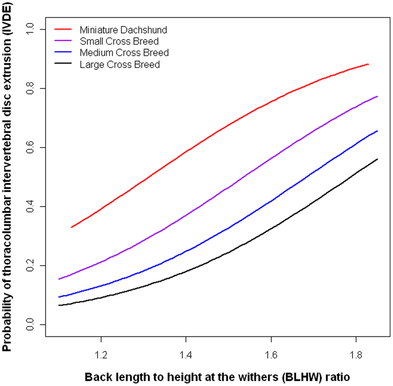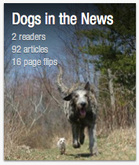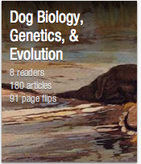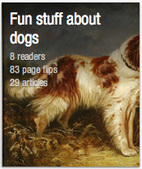
Abstract
Intervertebral disc extrusion (IVDE) is a common neurological disorder in certain dog breeds, resulting in spinal cord compression and injury that can cause pain and neurological deficits. Most disc extrusions are reported in chondrodystrophic breeds (e.g. Dachshunds, Basset Hounds, Pekingese), where selection for ‘long and low’ morphologies is linked with intervertebral discs abnormalities that predispose dogs to IVDE. The aim of this study was to quantify the relationship between relative thoracolumbar vertebral column length and IVDE risk in diverse breeds. A 14 month cross-sectional study of dogs entering a UK small animal referral hospital for diverse disorders including IVDE was carried out. Dogs were measured on breed-defining morphometrics, including back length (BL) and height at the withers (HW). Of 700 dogs recruited from this referral population, measured and clinically examined, 79 were diagnosed with thoracolumbar IVDE following diagnostic imaging ± surgery. The BL:HW ratio was positively associated with IVDE risk, indicating that relatively longer dogs were at increased risk, e.g. the probability of IVDE was 0.30 for Miniature Dachshunds when BL:HW ratio equalled 1.1, compared to 0.68 when BL:HW ratio equalled 1.5. Additionally, both being overweight and skeletally smaller significantly increased IVDE risk. Therefore, selection for longer backs and miniaturisation should be discouraged in high-risk breeds to reduce IVDE risk. In higher risk individuals, maintaining a lean body shape is particularly important to reduce the risk of IVDE. Results are reported as probabilities to aid decision-making regarding breed standards and screening programmes reflecting the degree of risk acceptable to stakeholders.
Packer, RMA, A Hendricks, HA Volk, NK Shihab, & CC Burn. 2013. How long and low can you go? Effect of conformation on the risk of thoracolumbar intervertebral disk extrusion in domestic dogs. PLoS ONE 8(7): e69650. doi:10.1371/journal.pone.0069650
Intervertebral disc extrusion (IVDE) is a common neurological disorder in certain dog breeds, resulting in spinal cord compression and injury that can cause pain and neurological deficits. Most disc extrusions are reported in chondrodystrophic breeds (e.g. Dachshunds, Basset Hounds, Pekingese), where selection for ‘long and low’ morphologies is linked with intervertebral discs abnormalities that predispose dogs to IVDE. The aim of this study was to quantify the relationship between relative thoracolumbar vertebral column length and IVDE risk in diverse breeds. A 14 month cross-sectional study of dogs entering a UK small animal referral hospital for diverse disorders including IVDE was carried out. Dogs were measured on breed-defining morphometrics, including back length (BL) and height at the withers (HW). Of 700 dogs recruited from this referral population, measured and clinically examined, 79 were diagnosed with thoracolumbar IVDE following diagnostic imaging ± surgery. The BL:HW ratio was positively associated with IVDE risk, indicating that relatively longer dogs were at increased risk, e.g. the probability of IVDE was 0.30 for Miniature Dachshunds when BL:HW ratio equalled 1.1, compared to 0.68 when BL:HW ratio equalled 1.5. Additionally, both being overweight and skeletally smaller significantly increased IVDE risk. Therefore, selection for longer backs and miniaturisation should be discouraged in high-risk breeds to reduce IVDE risk. In higher risk individuals, maintaining a lean body shape is particularly important to reduce the risk of IVDE. Results are reported as probabilities to aid decision-making regarding breed standards and screening programmes reflecting the degree of risk acceptable to stakeholders.
Packer, RMA, A Hendricks, HA Volk, NK Shihab, & CC Burn. 2013. How long and low can you go? Effect of conformation on the risk of thoracolumbar intervertebral disk extrusion in domestic dogs. PLoS ONE 8(7): e69650. doi:10.1371/journal.pone.0069650
 RSS Feed
RSS Feed





